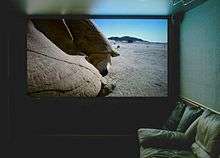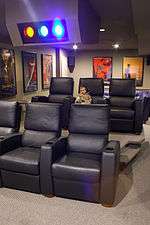Video projector

A video projector is an image projector that receives a video signal and projects the corresponding image on a projection screen using a lens system. All video projectors use a very bright light to project the image, and most modern ones can correct any curves, blurriness, and other inconsistencies through manual settings. Video projectors are widely used for many applications such as conference room presentations, classroom training, home theatre and concerts. Projectors are widely used in many schools and other educational settings,[1] sometimes connected to an interactive whiteboard to interactively teach pupils.
Overview
A video projector, also known as a digital projector, may project onto a traditional reflective projection screen, or it may be built into a cabinet with a translucent rear-projection screen to form a single unified display device.
Common display resolutions for contemporary (as of 2012) portable projectors include SVGA (800×600 pixels), XGA (1024×768 pixels), 720p (1280×720 pixels), and 1080p (1920×1080 pixels).
The cost of a device is determined by its resolution and its light output. A projector with a higher light output (measured in lumens, “lm”) is required for a larger screen or for a room with a larger amount of ambient light.[2] For example, a light output of approximately 1500 to 2500 ANSI lumens is suitable for small screens viewed in rooms with low ambient light; approximately 2500 to 4000 lm is suitable for medium-sized screens with some ambient light; over 4000 lm is needed for very large screens or for use in rooms with no lighting control such as conference rooms.
A few camcorders have a built-in projector suitable to make a small projection; a few more powerful "pico projectors" are pocket-sized, and many projectors are portable.
Projection technologies

- CRT projector using cathode ray tubes. This typically involves a blue, a green, and a red tube. This is the oldest system still in regular use, but falling out of favor largely because of the bulky cabinet. However, it does provide the largest screen size for a given cost. This also covers three-tube home models which, while bulky, can be moved (but then usually require complex picture adjustments to get the three images to line up correctly).
- LCD projector using LCD light gates. This is the simplest system, making it one of the most common and affordable for home theaters and business use. Its most common problem is a visible “screen door” or pixelation effect, although recent advances have reduced the severity of this effect.
- DLP projector using Texas Instruments’ DLP technology. This uses one, two, or three microfabricated light valves called digital micromirror devices (DMDs). The single- and double-DMD versions use rotating color wheels in time with the mirror refreshes to modulate color. The most common problem with the single- or two-DMD varieties is a visible “rainbow” which some people perceive when moving their eyes. More recent projectors with higher speed (2x or 4x) and otherwise optimised color wheels have lessened this effect. Systems with 3 DMDs never have this problem, as they display each primary color simultaneously.
- LCoS projectors (liquid crystal on silicon). Such projectors often process light in the Fourier domain, which enables correction of optical aberrations using Zernike polynomials.[3] Some commercially available technologies include:
- LED projectors use one of the above-mentioned technologies for image creation, with a difference that they use an array of Light Emitting Diodes as the light source, negating the need for lamp replacement.
- Hybrid LED and laser diode system developed by Casio. Uses a combination of Light Emitting Diodes and 445 nm laser diodes as the light source, while image is processed with DLP (DMD) chip.
- Laser diode projectors have been developed by Microvision and Aaxa Technologies. Microvision laser projectors use Microvision's patented laser beam-steering technology, whereas Aaxa Technologies uses laser diodes + LCoS.
Obsolete technologies
- Eidophor oil-film projectors
- LIA (light image amplifier) light valves
- Schmidt-CRT, developed by Kloss Video
- Talaria oil-film projectors
Do-it-yourself video projectors
Some hobbyists take a do-it-yourself (DIY) for low cost. They build their own projectors from kits, sourced components, or from scratch. Through the internet, they obtain plans to construct them [4] for domestic and classroom use. The DIY-projectors are now being used both in developed countries and in developing countries in the interest of providing education as well as for entertainment purposes.
See also
- 3LCD
- LCD projector
- Comparison of display technology
- Digital cinema
- Digital divide
- Digital Light Processing (DLP)
- Handheld projector
- Inflatable movie screen
- Large-screen television technology
- Live event support
- Projection screen
- Projector (disambiguation)
- Screen door effect
- Video designer
References
- ↑ Charles Proctor (January 18, 2007). "Christmas is a time for taking -- from schools". Los Angeles Times. Retrieved 2010-11-26.
- ↑ Richard Cadena (2006). Automated Lighting: The Art and Science of Moving Light in Theatre, Live Performance, Broadcast, and Entertainment. Focal Press. p. 344. ISBN 978-0-240-80703-4.
- ↑ Kaczorowski, A., Gordon, G.S.D., Palani, A., Czerniawski, S. and Wilkinson, T.D. (2015) “Optimization-Based Adaptive Optical Correction for Holographic Projectors”, IEEE/OSA Journal of Display Technology, 11 (7).
- ↑ Frank Völkel (November 13, 2004). "Supersize Your TV for $300: Build Your Own XGA Projector!". Tom's Hardware. Retrieved 2010-11-26.